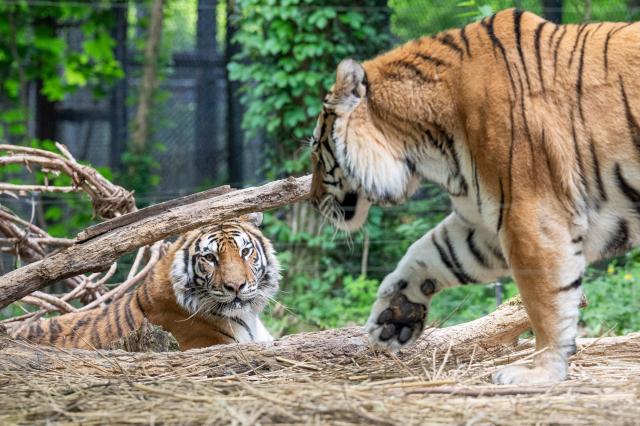
SEOUL, May 30 (AJU PRESS) - The illegal wildlife trade is one of the greatest threats to all Asian big cats – tigers, leopards, snow leopards and Asiatic lions, as well as lesser-known species including clouded leopards and the Asiatic cheetah. For that reason, Asian big cats are some of the most strictly protected animals under international law and the Convention on International Trade in Endangered Species of Wild Fauna and Flora, better known as Cites.
But the illegal trade in big cats remains a global issue that affects a diverse range of countries. And, concerningly, it continues to evolve. Major global transport hubs, such as the U.K.'s Heathrow Airport, are required to remain constantly vigilant for the smuggling of big cat body parts and other wildlife contraband.
One country that has been largely overlooked by the global conservation community is Korea. In the 1990s, a series of reports identified Korea as a major player in a trade that was pushing tiger populations to the brink. As a conservation biologist working in partnership with the Tiger and Leopard Conservation Fund in Korea, I wanted to find out what had happened in the 30 years since.
The Korean Peninsula was historically home to both Amur tigers and Amur leopards. In the late 19th century, as the country's ports opened to international trade, there was a wave of exports of big cat skins.
Local populations of these rare animals were quickly depleted and the last tigers in southern Korea were killed in the early 1920s by Japanese trophy hunters. The Amur leopard managed to survive through the Korean War (1950~53), but finally succumbed to hunting pressure in 1970. This resulted in Korea shifting from being an exporter to a major importer in the international big cat trade.
By the early 1990s, Korea was one of the world's largest importers of tiger bone. Alongside China, it was also a major global manufacturer of tiger bone-derived products, exported for use in various traditional Asian medicines.
The quantities are staggering, given how rare tigers are today. Between 1970 and 1993, Korea imported tiger bone amounting to between 600 and 750 complete tiger skeletons. Almost half of this came from Indonesia, where the native Sumatran (or Sunda Island) tiger is critically endangered.
All of this was to change when the Korean government, concerned about the threat of potential U.S. trade restrictions, agreed to join Cites in 1993. A domestic ban on the big cat trade followed a year later. But, remarkably, there has since been little domestic or international attention on the results of this major policy shift.
Our team set to work collating three decades of wildlife trade records and interviewing experts in big cat trade, trade policy and law enforcement. Encouragingly, we could find no evidence for any large-scale tiger trade linked to Korea. While further investigation is needed, this appears to represent a major achievement considering the size of the Korean market for tiger bone in the early 1990s.
What made the difference for Korea? On this, participants were less certain. The country's geographical isolation is notable – it has a single, heavily-fortified land border (the DMZ), so all big cat products would have to arrive via plane or ship. But isolation is also true of all countries that are natural islands.
Most participants instead leaned towards a three-pronged explanation: a trade ban that was publicly perceived to be strictly implemented, strong influences of social stigma on consumption choices, and the country's impressive economic growth resulting in widespread access to cutting-edge medical services and more desirable luxury consumer items.
Previous studies have warned that Asia's economic growth could lead to increased regional demand for tiger products. But Korea shows that this need not be true.
Threats to progress
The broad trends indicate positive steps in the right direction. But a search of online forums and marketplaces did turn up products currently on sale reporting to be derived from tiger. Commonly, these were claimed to be old bottles of tiger bone wine.
These attempted sales were public. They did not involve shady backroom deals in brick-and-mortar stores or secret online chat groups. Rather, they were happening on the same platforms where you could buy a smartphone, packaged food items or the latest K-pop merchandise.
The attempted sales were strictly illegal under Korean law and action is required by law enforcement and policy makers to address such cases, or they may risk undermining the progress that has otherwise been made.
Tigers are legally some of the best protected animals on the planet. They are regularly ranked among the most charismatic of all species, and from 2010 to 2022 they were subject to a unique conservation effort to double their global population size (a target that there was progress towards, but has never been met).
Combatting the illegal tiger trade serves as a test of our commitment to addressing the wider threat of illegal and unsustainable wildlife trade. That requires a global effort. It is important to both learn from what different countries have achieved and identify illegal trade wherever it persists.
In this, Korea can play a key role. Hopefully, it will not be overlooked any longer.
-------------------------------------------------------------------------------------------------------------------------
Joshua Elves-Powell is a PhD researcher, Conservation Biology at UCL in the U.K.
This article was republished under a Creative Commons license with The Conversation. The views and opinions in this article are solely those of the author.
https://theconversation.com/could-south-korea-become-a-model-for-tackling-illegal-tiger-trade-230717
Copyright ⓒ Aju Press All rights reserved.

View more comments